Last week I visited my favorite trail at Willapa National Wildlife Refuge. The Cutthroat Climb (named for the cutthroat trout that spawn there, not a murderer!) is a 3/4 mile loop through recovering mixed conifer forest on the east side of Willapa Bay by the former Refuge headquarters. It’s one of the more challenging hikes with steep stairways and muddy trails in wet weather, and those with unsure footing may be challenged by the many roots and trail areas where bare sedimentary rock* has been exposed through erosion. But it’s a place full of beauty and ecological complexity, even as it also bears telltale scars of a history of logging. One of my favorite things about this trail are the many nurse stumps, as well as “ghost trees” along the way. These are places where the roots of living trees hint at the existence of their old-growth nurse stump predecessors even though no physical trace of these ancient trees may remain.
What is a Nurse Stump?
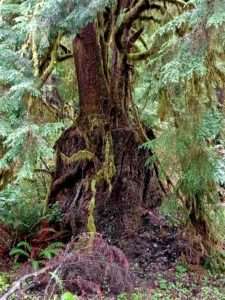 Nature wastes nothing. If there is a nutrient source to be had, there is a being to exploit it. It may take a while; for example, the Carboniferous Period was so named because nothing had yet evolved to digest the lignin in the earliest true trees, and so much carbon was locked up in undecaying dead trees that it created huge beds of coal–and contributed to a global cooling event. But eventually some white rot fungus evolved the enzymes to be able to break down lignin, and the entirety of a dead tree could be effectively recycled.
Nature wastes nothing. If there is a nutrient source to be had, there is a being to exploit it. It may take a while; for example, the Carboniferous Period was so named because nothing had yet evolved to digest the lignin in the earliest true trees, and so much carbon was locked up in undecaying dead trees that it created huge beds of coal–and contributed to a global cooling event. But eventually some white rot fungus evolved the enzymes to be able to break down lignin, and the entirety of a dead tree could be effectively recycled.
We can easily see this today in any reasonably mature forest. Dead trees are not merely wasted timber dollars; rather, they are sources of food for literally thousands of beings in this ecosystem, from tiny microscopic beings to insectivorous birds. A standing dead tree is known as a snag, while a fallen dead tree is a nurse log. A cut or natural stump can serve the same ecological function even though its death was at human hands, and so we can call it a nurse stump.
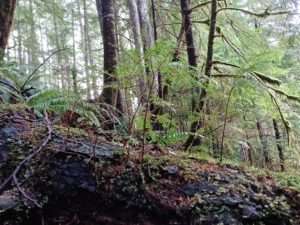
Nurse stumps and logs, as well as snags, have almost always already been colonized by numerous other beings. Living trees provide shelter for animals and places for small plants, fungi, and lichens to grow, to say nothing of the countless microorganisms they support. If a tree become sick, though, its immune system can no longer fight off infections, and some of these microorganisms may become more aggressive. Some fungi, for example, may begin rotting the tree’s wood from the inside, or parasitic insects may burrow under the bark more readily. Either way, by the time the tree dies it is likely already feeding numerous scavengers.
Even if a healthy tree falls over, say, due to a windstorm or landslide, it’s not long before it too begins to support an increasingly complex ecosystem of smaller beings that break it down into its component nutrients. This nurse log, and its standing snag and nurse stump neighbors, may play host to all sorts of mosses, lichens, fungi, insects and other arthropods, many of which may be hidden deep inside, as well as other living beings that prey on them. In this way the dead tree becomes a food pantry for the smallest beings, and its nutrients begin to radiate outward into the food web as smaller beings are eaten by larger ones, and those by even larger predators, and so on. Eventually some of the nutrients find their way back to other trees through the soil and mycorrhizal fungi.
Dead Trees Do Tell Tales
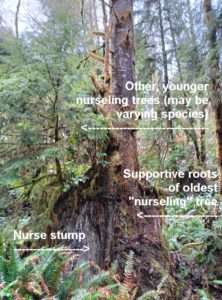
Sometimes a nurse stump sports a tiny tree seedling or three. In some cases this is the original tree managing to re-sprout even after being cut down or snapping while falling over. Other times the seeds of other trees landed in a favorable patch of debris on the stump and found enough water and nutrients to grow; they may not even be the same species as the nurse stump. The tree sprouts usually have neighbors of other plants sharing the stump, but as in any forest the little trees quickly outgrow these shorter plants.
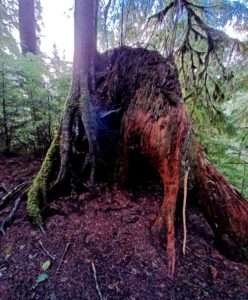 As the seedling grows bigger, it takes advantage of the nutrients being freed up as the nurse stump decays. Small seedlings are completely physically supported by the stump, but with time and growth they start putting down roots along the outside edge of the old tree and into the soil. These help to support the young tree while the stump continues to fall apart, and new roots may venture downward anywhere the stump’s wood has weakened enough, providing more support and nutrients.
As the seedling grows bigger, it takes advantage of the nutrients being freed up as the nurse stump decays. Small seedlings are completely physically supported by the stump, but with time and growth they start putting down roots along the outside edge of the old tree and into the soil. These help to support the young tree while the stump continues to fall apart, and new roots may venture downward anywhere the stump’s wood has weakened enough, providing more support and nutrients.
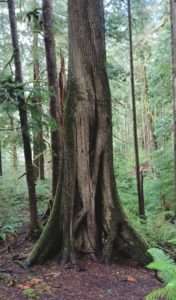 Eventually the stump decays away entirely apart from a scattering of nutrients in the surrounding soil, and the younger tree–which may be several decades old by this point–is completely self-supporting. But you can still see something of an outline of the old stump in the exposed root structure of the living tree, and read the poignant story of how the stump supported new lives while falling apart piece by piece.
Eventually the stump decays away entirely apart from a scattering of nutrients in the surrounding soil, and the younger tree–which may be several decades old by this point–is completely self-supporting. But you can still see something of an outline of the old stump in the exposed root structure of the living tree, and read the poignant story of how the stump supported new lives while falling apart piece by piece.
Do be aware that not every tree with extensively exposed roots once had a nurse stump. Some trees just naturally have exposed roots, particularly as they age, though these rarely have as much vertical space beneath them as a tree raised by a nurse stump. Erosion can also cause a tree’s roots to be exposed, and often that tree may have to build a more robust root structure to stay upright. If the tree is on a hillside or along a waterway, if there are signs of an old landslide, or if the underside shows signs of extensive excavation by animals, it is more likely that erosion (with or without animal activity) is the reason for the root exposure.
However, if you see a tree on a relatively level area of land with at least several vertical feet of exposed roots that have grown like columns (up and down rather than outward), and especially if you see nurse stumps in the area, it’s a good bet that that tree also once had its own nurse stump caring for it through its early decades. Take a moment to consider the size of the old tree, and how amazing it is that this story of death-into-life can be read for literally centuries after it was first written.
* The hills directly east of this section of Willapa Bay are made of Eocene siltstone of Shoalwater Bay that ranges in age from 34 to 56 million years old. Willapa Bay was formerly known as Shoalwater Bay to European colonizers, until it was renamed Willapa Bay after the original inhabitants of this area.
